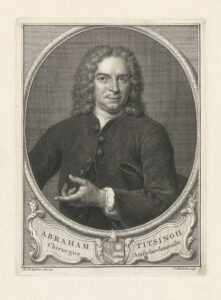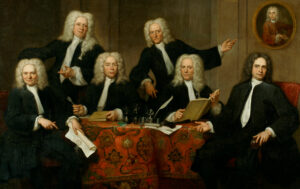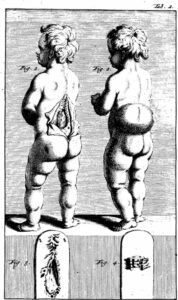The history of Abraham Titsingh (1684-1776) as a surgeon.
Peter J. Koehler
“In the year 1709, A van D, sailor on the country’s warship Catwijck, commanded by the Lord Captain De Veth, was in the Sloop, while it was put out, and when the rear hoist broke, he fell with the right side of his head on the barrel of the cannon: I found him as a Sufferer, who was lying stricken, in a deep Sleep, Motionless and Feelingless, which Accidents usually accompany those who have so fallen, because the Brain, being shaken by the Fall, or Stroke; its Fluids in its Movements, and the Vessels in its Workings, are hindered, especially that, by which the stirring and feeling is working on our muscles, and that alone is powerful to kill us. It also happens, when only the Shaking of the blow is the Cause of this, that these Accidents do not last long; for after bloodletting, which in all, who have fallen on the Head, or have been severely beaten, is duly applied as the first Means, it frequently disappears, and then I saw them as awakening, and looking about with astonishment.” 2p.54-5 (See Figure 1.)
It occasionally happened that the surgeon diagnosed temporary paralysis.
Sometimes, during one or more minutes, an arm or leg would remain blocked, on the bruised side, or on the opposite side, and this immediately gave me the impression, as if they were broken; but while I was examining this, the forces resumed, and then they looked, like someone stricken with a violent fever. As soon as they consume any liquid, they gag and vomit. If one touches the head, one finds the place where the blow came, impression …1,p.54-5

Figure 1. Frontispice of Titsingh’s book De verdonkerde heelkonst der Amsterdammers uit hunne eigen Handvesten, 1730.
Abraham Titsingh (1684-1776), the ship’s surgeon who wrote this in 1730, had observed this picture more often. See Figure 2. He not only felt an impression, but soon often a swelling would start. The injured persons often continued vomiting from time to time. He felt it was important to write this down because surgeons often did not see these patients until after this episode was over. The patient would be put in bed, the hair should be shaven, and “the hairy scalp was to be stewed with wool rags boiled in wine containing warming herbs.” Others would use brandy for this purpose.
Bed Rest
Bed rest should be continued for several days, in combination with “a cooling lifestyle.” He compared the case with a squire, identified as JVK, who had fallen from a moving carriage and was apparently dead, but recovered after a bloodletting. He had a big bump on the forehead and had to keep to bed for a month. For the first 14 days, he swooned every time he stood up.1,p.55
Trepan
Titsingh criticized the ship’s surgeons who did not bring the trepan on board because it would be useless due to the ship’s movements. He was aware of which locations one should not trephine.
“It should also be noted that one should not trephine on the sutures too lightly, and never on the Sutura Sagittalis, because there the Sinus Longitudinalis runs under it; for if one were to drill into it, one would obtain such a great blood discharge that death must necessarily follow.”1p,53 Moreover, he knew of the danger of skull fractures. In some cases, but not all, it was necessary to trephine to make room, “lest the deposited blood, or its decay, or the departed bone splinters, damage the brain.”1,p.53-4

Figure 2. Portrait of Abraham Titsingh, by Jacob Houbraken, after Jan Maurits Quinkhard, 1742-1780, engraving, 18.5 x 13.1 cm, Amsterdam, Rijksmuseum (object number RP-P-OB-48.331; public domain).
Drunken Sailor
Another case he described was of a drunken sailor who fell in the cable hole with his head on the tip of a grapnel. He had a large wound on the side of the back of his head, where Titsingh could feel the injury of the skull with his finger. The wound was bleeding unusually heavily and prevented him from continuing. He was unable to stop the bleeding, and the man died the same evening. The next morning, he and a colleague dissected the skull and diagnosed a fracture with impression, as well as bone chips that reached to the meninges. Moreover, he suspected that the transverse sinus was damaged, “which we did not investigate, but let him rest with the dead.”1,p.60
Son of Ship’s Surgeon
Abraham Titsingh was the son of an Amsterdam ship’s surgeon who worked for the Dutch fleet. The latter died during the Nine Year War (1688-1697) against the French, when Abraham was only 10 years old. After his father’s death, he was taught the healing arts by a Swedish ship’s surgeon, who was an excellent teacher. Abraham’s two brothers Gerard and Isaak also became surgeons in Amsterdam. At least one of them, Isaak, was partly trained by Abraham. In 1702, Abraham was promoted to second ship’s surgeon.1 He was a rough ship’s lump and had little respect for his superiors, but was beloved among the ship’s people. 2, p.134 He remained in the country’s service until 1710, when he settled in Amsterdam as a surgeon, having taken his master’s examination in 1711.
He became surgeon of the admiralty and guild master. In the surgeon’s guild, he later brought about considerable change in the administration that was unprecedented in its history. He brought to light that the incumbent overlords had defrauded the surgeon’s diplomas and the guild treasury. The result was that the entire corrupt guild board was deposed in 1732. Titsingh himself stayed on after the guild board was purged.3 In the same year, the new guild board under leadership of Titsingh was depicted in a group portrait by the painter Jan Maurits Quinkhard (1688-1772). See Figure 3.

Figure 3. Overlords of the surgeon’s guild of Amsterdam (1732) with Titsingh on the far right; made by Jan Maurits Quinkhard, oil on canvas, 176.5 x 273 cm, Amsterdam Museum (object number SA 454; public domain).
Spina Bifida
Titsingh was critical of guild exams and was hated by his fellow surgeons. He believed practice was more important than theory, and that experience at the bedside was “the safest and surest way.”2,p.136 In particular, he criticized theorists. “The reflective pedants misled the young through unproven feelings. They wrote medicinal novels, emblems with sharp acid, salt, oily grease, and other blanket particles”.1,p.792 However, he published several books himself, including Heelkundige verhandeling over de tegennatuurlijke splijtinge der ruggegraad [Surgical Treatise on the Unnatural Splitting of the Spine]. See Figure 4.5 The subtitle was “Geschreven aan den uitmuntende chirurgyn Hendrik Ulhoorn” [Written to the excellent surgeon Hendrik Ulhoorn]. In fact, he was writing against an earlier treatise on the same subject by his fellow surgeon and citizen Hendrik Ulhoorn (c. 1687-1746), who sought the cause of the defect largely in an unnatural bending of the fetus in the womb. Titsingh, however, ruled that it consisted of defective development of the vertebrae of the spine, caused by dropsy and often accompanied by hydrocephalus, and also did not exonerate the woman’s imagination in some cases.

Figure 4. From Titsingh’s Heelkundige verhandeling over de tegennatuurlijke splijtinge der ruggegraad [Surgical Treatise on the Unnatural Splitting of the Spine] (1736).
Titsingh’s point of contention was mainly directed against Ulhoorn’s idea that the surgical training, especially in Leiden, was inadequate, and that it was better to go to Paris. Ulhoorn had indeed studied at Leiden University, but later traveled to Brussels and Paris. In the latter city, he trained in surgery under Joseph Guichard Duverney (1649-1730), after which he settled in Amsterdam and inscribed at the Guild in 1715. Titsingh did not agree at all about Ulhoorn’s ideas on training.5,p.2011 On the contrary, he believed it was excellent in Leiden. In the book, he referred to several authors who had written on spina bifida, including his fellow citizen medicinae doctor Nicolaas Tulp (1593-1674).6
In 1750, Titsingh published Diana, ontdekkende het geheim der dwazen, die zich vroedmeesters noemen [Diana: Discovering the Secret of Fools Who Call Themselves Midwives], in which he criticized the attitude of some midwives who were interested in money, rather than a humane and considerate manner to assist and help the woman in childbed.1,p.793 In mythology, Diana was not only the goddess of hunting, but also of chastity and pregnant women.
His last book was Geneeskonst der Heelmeesters tot dienst der Zeevaart [Medicine of Surgeons to the Service of Seafaring].7 On the title page, he mentioned that he was “surgeon of the country’s fleet.” In this book, one finds some reports from ship’s surgeons about various diseases treated by them on their voyages, both on board and on land, in foreign places. He wrote on their medical treatment, about which he widely communicates his reflections, remarks, and clarifications.
Not Only Surgical Cases
Ship’s surgeons did not only treat surgical cases. The surgeon’s chest they brought on board contained instruments as well as medicines. The contents of the ship’s pharmacy were subject to precise regulations. The Dutch United East India Company made a list of no less than 144 substances in 1704.

Figure 5. Ship of the Dutch United East India Company by Gerrit Groenewegen, 1786, engraving, 13.1 x 15 cm, Amsterdam, Rijksmuseum (object number RP-P-1910-3459, public domain).
Before each voyage, the chest was subjected to a careful inspection in front of the ship’s surgeon by a physician
and surgeons appointed for that purpose.9,p. 26-7 Ship’s journals from the late 17th and early 18th century show that scurvy was the leading cause of death during longer outward voyages to the Cape of Good Hope, in particular if changes in weather and wind caused delays. See Figure 5. As can be expected, there was a relation with the duration of the voyage. None of the voyages with high scurvy mortality during that period lasted less than 19 weeks.8, p. 52 A Treatise of the Scurvy by James Lind (1716-1794), who had been employed by the Royal Navy between 1738 and 1748, appeared in 1753.9 However, the proposed treatment was not immediately adopted by all doctors and surgeons. The lack of a generally accepted theoretical explanation for his observations played an important role here.10
In his book Harde Heelmeesters [Tough Surgeons], physician Arnold E. Leuftink described the backgrounds of illness and death among 18th century sailors and soldiers, as well as the medical care of the ship’s surgeons, using ship’s journals as sources. Infectious diseases were common already upon leaving Europe. Respiratory diseases with coughing and rheumatic complaints were also common. Rain and storms sometimes led to the crew being constantly at work, wearing wet clothes, and often falling ill due to lack of sleep. And then, of course, there were the seasick soldiers.9,p.69-70
Quarrelsome Person
According to his biographer, the physician Jelle Banga (1786-1877), all of Titsingh’s writings have something unpleasant, something pugnacious, because of the repeated broad enumeration of his grievances, and something cumbersome because of the elaborate and embellished surgical considerations. The language is flat, uncivilized, and generally prickly and snappy. The style is confused, without coherence, broken up by all kinds of inappropriate ideas, idle thoughts, and short-tempered pranks, which according to his own confession he could not avoid writing. Banga believed it was due to the fact that he had not been properly educated in his early youth and only trained to follow his father’s example.
For eight years, he worked as a ship surgeon with rough sailors, roaming everywhere. He was enterprising by nature, but he seems to have applied himself to his craft only with zeal. Only when he established himself as a surgeon in Amsterdam did he realize his flaws. In the exercise of his art, he showed himself to be a gentle and experienced surgeon.1,p.795 •
References
-
Banga JJ. Geschiedenis van de Geneeskunde en van hare beoefenaren in Nederland. Part II. Leeuwarden, Eekhoff, 1868.
-
Snelders S. Vrijbuiters van de heelkunde. Op zoek naar medische kennis in de tropen 1600-1800. Amsterdam/Antwerpen, Atlas, 2012.
-
IJpma FF, Teulings C, van Gulik TM. Gildepenningen van de Amsterdamse chirurgijns [Guild medals from the Surgeons’ Guild of Amsterdam]. Ned Tijdschr Geneeskd. 2015;159:A8647.
-
Titsingh A. Heelkundige verhandeling over de tegennatuurlijke splijtinge der rugge-graat. 2nd edition. Amsterdam, Graal, 1736.
-
Lindeboom GA. Dutch Medical Biography. Amsterdam, Rodopi, 1984.
-
Koehler PJ. Neurology in Tulp’s Observationes medicae. J Hist Neurosci. 1996 Aug;5(2):143-51.
-
Titsingh A. Geneeskonst der Heelmeesters tot dienst der Zeevaart. Amsteldam, Wor, 1752.
-
Leuftink AE (1991). Harde heelmeesters. Zeelieden en hun dokters in de 18e eeuw. Zutphen, Walburg.
-
Milne I. Who was James Lind, and what exactly did he achieve. J R Soc Med. 2012 Dec;105(12):503-8
-
Lind J. A Treatise of the Scurvy. Edinburgh: Sandi, Murray and Cochrane; 1753.
